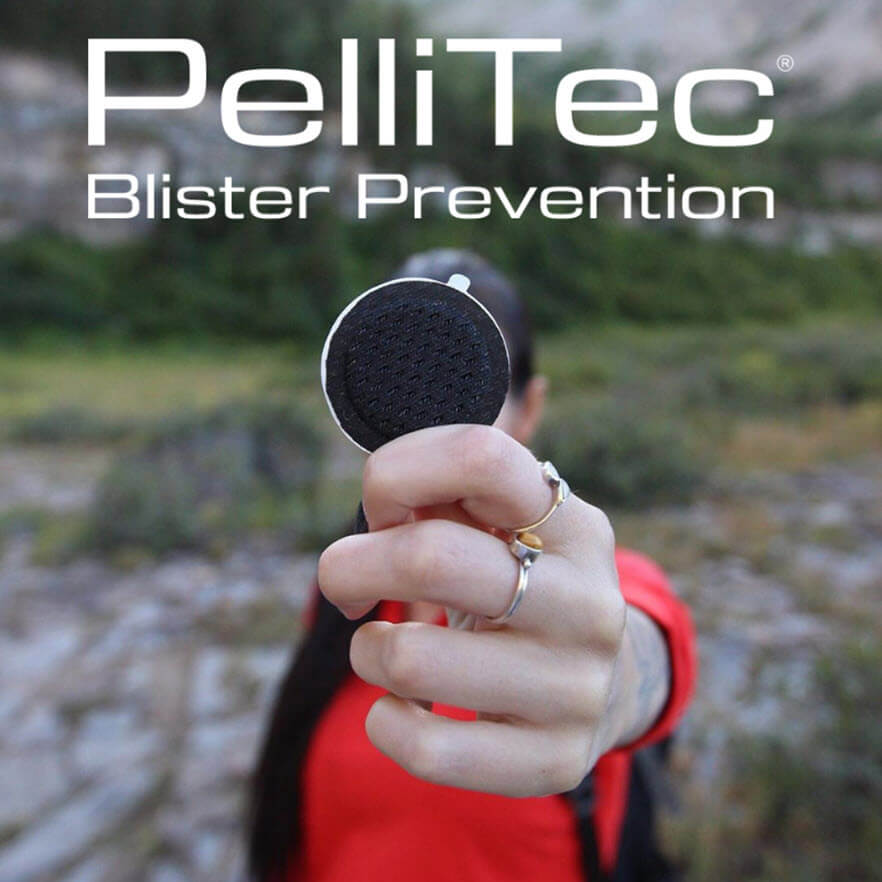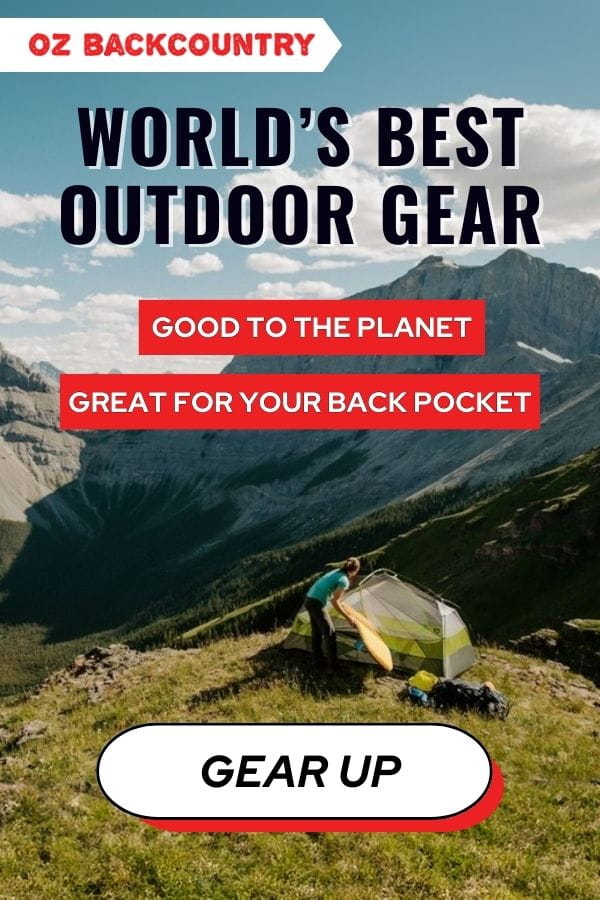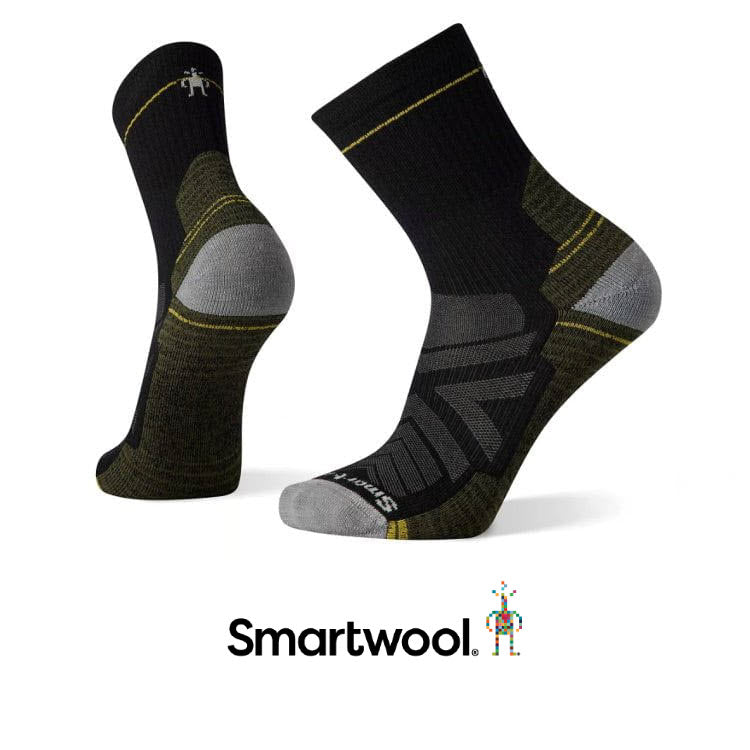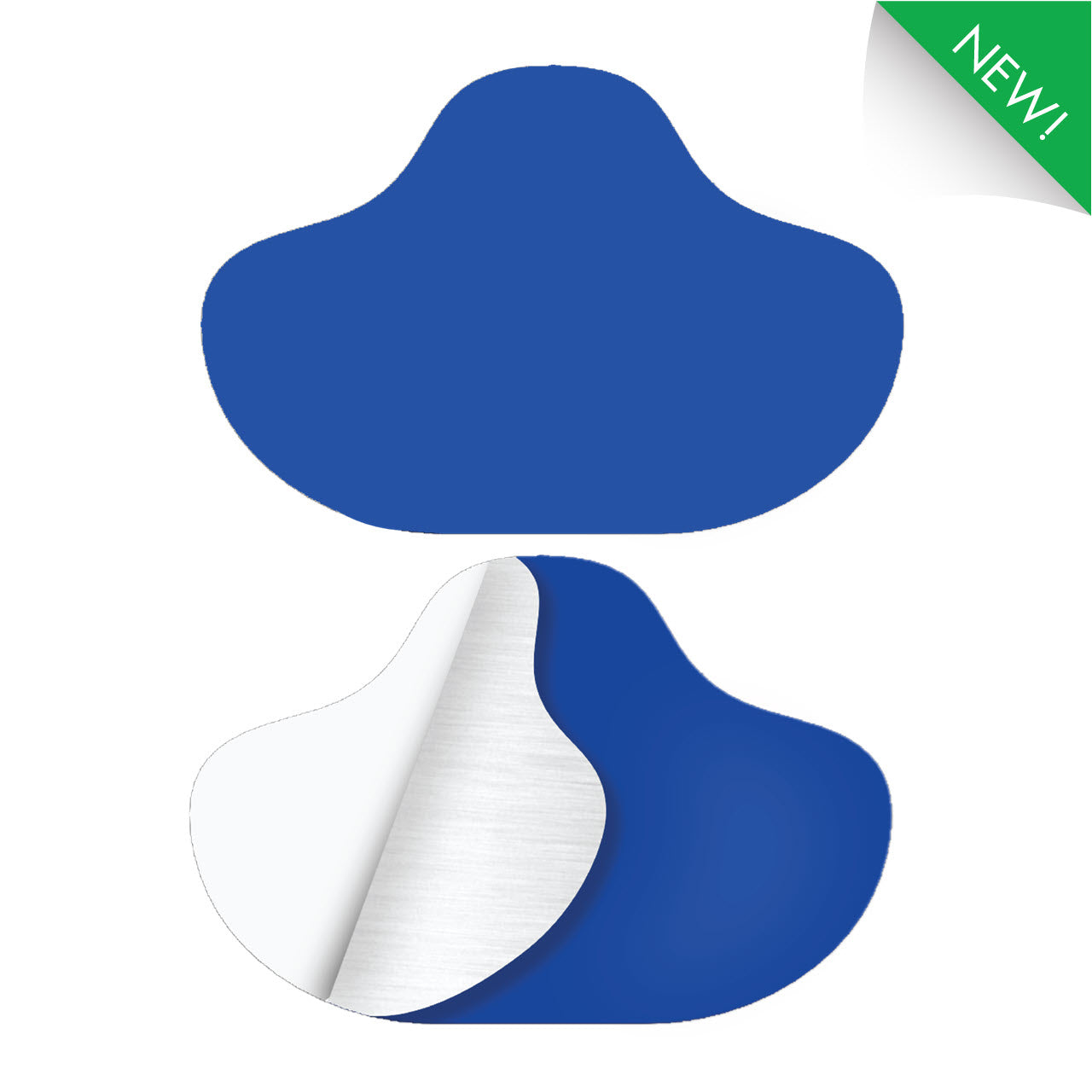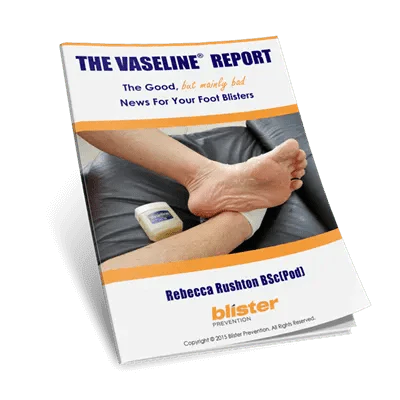PelliTec Blister Prevention Pads from UK company, PelliTec are the newest thing in blister prevention. They're a rather unique self-adhesive pad with multiple material layers. Similar to ENGO Blister Patches, which I have a lot of experience with, these pads stick to your shoe, not your foot. But there are significant differences. PelliTec's composition is described as a 6-layer breathable sandwich construction. We'll look at this closer in this article, and even more so in the video below. PelliTec were nice enough to send me several samples and I've had several customers test them out. We got some really informative feedback – both positive and negative, which is great. Because the last thing you want to read is one-sided spin. I look forward to sharing that feedback with you in this article.
PelliTec Pad 6-Layer Sandwich Construction
PelliTec Pads contain several material layers that are central how they protect against blisters caused by friction. Here's a great picture showing the 6 material layers making up the PelliTec "sandwich".
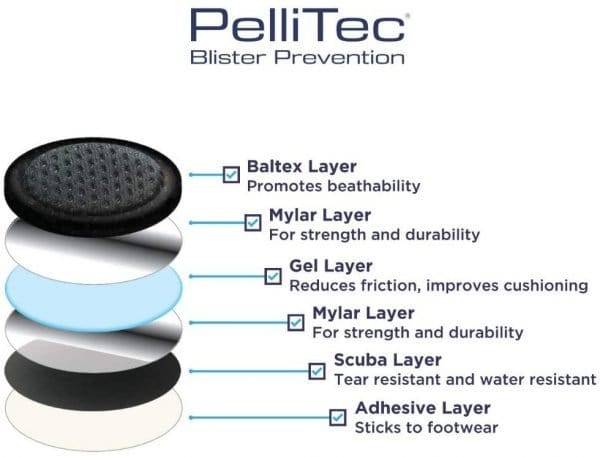
PelliTec Pad 6-layer sandwich construction
- Baltex - Breathablility
- Mylar - Strength and durability
- Gel - Reduces friction, improves cushioning
- Mylar - Strength and durability
- Scuba - Tear and water resistant
- Adhesive - Sticks to footwear
Keen to understand these layers more and how they actually work to prevent blisters, there was only one thing to do - cut one open (watch the video at the top of this article). The layers are very distinct, but from what I can tell, there doesn't seem to be the 4th layer of Mylar. So I sought clarification:
As the pads are a relatively new product on the market we are refining the design within our specification criteria as part of ongoing continuous improvement work. The 4th layer is now based on a slightly stretchy mylar type layer which works well with the gel, top mylar layer and Baltex.
PelliTec Pad Dimensions
- Diameter: 4.5cm
- Middle: 2mm
- Edges: 1mm
How Do PelliTec Pads Work?
Suggested for use in sport and hiking, they are also being tested in the high risk setting (ulcers, diabetic foot issues). The manufacturers report the mechanism by which their pads prevent blisters is to:
...cushion and protect the affected area wicking away moisture thereby reducing pressure, pain and the risk of infection.
The product dries out quickly after being damp and stays in tact and in place in the boots. The pad sticks to your insole or shoe, not your skin!
The unique sandwich construction moves with your foot significantly reducing the friction which causes blisters.
My Thoughts On How PelliTec Pads Work
The video at the top of this article is the best way to see the material layers and understand my thoughts on how they work. However, if you're familiar with all the ways a product can potentially prevent blisters, here's the overview. PelliTec has chosen materials that could potentially perform three blister prevention functions:
1) Friction Management
First, there’s the outer BALTEX layer. This is the surface that’s in contact with your sock. The most obvious question I have about this layer is, how is this going to interact with the sock? Is this a low friction material? Because potentially, like ENGO Patches, this material is super low friction, so that the sock can glide back and forth on it easily. Not only in dry conditions, but also in sweaty moist conditions like it invariably is inside your shoe. Unfortunately, unless it’s obviously slippery or grippy, it’s not something you can accurately see. It needs to be measured in rather controlled conditions and compared to other materials under the same conditions. The manufacturers tell me they don’t have that information, which to be honest, isn't that surprising – not many blister products do. Though it is kind of frustrating because considering blister prevention products are designed to prevent “friction” blisters, you would think there’d be some investigation into “friction” levels, not least of which but to inform the material selection process during product development.
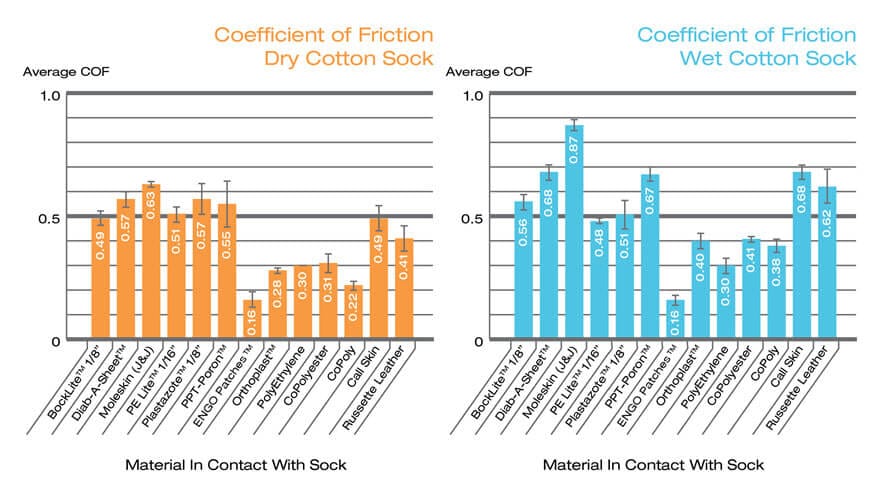
Friction levels of various in-shoe materials against a cotton sock in dry and moist conditions.
Moving on to the second layer - the MYLAR layer. Mylar looks like a thin clear plastic sheet which is hard, not at all stretchy but it is bendy. So, it’s not in any way what you’d call cushioning. But watch the video to see how freely the underside of the Baltex first layer glides back and forth over the Mylar. This seems to be a really low friction interface – interface just means where two things meet. We consider material interfaces a lot when we talk about blister prevention strategies that focus on friction levels. This easy movement is in DRY conditions, which doesn’t really mimic the in-shoe environment – ideally we’d measure this at 30% moisture. But this really easy movement between material layer 1 and 2 is blister prevention GOLD! If there’s enough easy and early slip here, the shear distortions that occur within the skin will be much less – which is the aim of the blister prevention game. However, the actual amount of slip will be much less. It will be constrained by the stretchiness in the Baltex layer, because it’s sewn or fused or joined in some way right around the edges of the pad. See how movement is limited. Sometimes, this small amount is all it takes to prevent a blister. Sometimes though you might need more. But this is one important way the PelliTec Blister Pad works at preventing blisters – the low friction interface between layers 1 and 2. Another limitation of this interface is the size of the Mylar layer. It doesn't reach the edge of the pad. It’s a smaller round disc with a diameter of 2.5cm. So this low friction level won’t work across the whole width of the pad. That’s a BIT of a downside if you have a large area that needs protection. But there is a benefit and that is, it doesn’t add to the thickness of the outer edge. At 1mm thick and with no bevel, those edges can be a bit irritating.
Perforations
One thing I am curious about is how the perforated surface effects the performance of the pad. I notice it seems easier and less abrasiv to move over the pad in the same direction as the perforations, as opposed to across the perforations. If there’s something in that, then this could be important for the placement of the pad. For example, at the back of the heel, knowing the heel moves up and down relative to the shoe, you’d want to place the pad with the perforations aligned vertically, not horizonal. I don’t really know if this is a thing, so don’t take this as gospel – but it might be something for the manufacturers to look at.
2) Pressure Management (Cushioning)
Being a "pad", the ability to cushion (which is a form of pressure-management) is central to its function. Material quality is important here. So is thickness - the thicker it is, the more it can cushion. But there's a fine line to be found. Thick materials take up room in your shoe and can negatively affect shoe-fit. Thick materials can effectively increase pressure - the very thing they are trying to avoid. It can be a fine line! Gels are known to have excellent cushioning properties. Not only that, Silipos is an excellent quality gel. Below is a nice picture showing how gels offer superior cushioning by way of cradling the bony prominence.

How cushioning reduces pressure, and how gels can do this best
However, the gel layer in the PelliTec pad is very, very thin - 0.15mm by my measurements. I'm not sure any gel this thin is going to be able to provide any cushioning at all. In addition, the very stiff Mylar layer that sits on top of the gel will prevent cradling of the bony prominence. So any cushioning there may be is somewhat nullifed by the Mylar.
3) Shear Absorption
Gels are also excellent at absorbing shear forces. The more shear distortion you can get occuring in an external material, the less shear stress required to occur within the skin. That's why I love gel toe protectors to prevent toe blisters. Our gel toe protectors have a 2mm thick layer of gel, which I concede, is very thick (twice as thick as most). The PelliTec Pad gel layer is only 0.15mm ie: 7.5% as thick. The gel layer seems quite stretchy, but as I show in the video, shear absorption seems almost indiscernible. I'm sure there's a bit of deformation that occurs, but it's not a lot - not as much as I often rely on to prevent blisters, callouses and ulcers (all shear-related lesions) every day in my podiatry clinic.
How Are PelliTec Pads Different To ENGO Patches?
PelliTec Pads and ENGO Patches are similar in that both stick to the shoe rather than the foot. This has big advantages over topical applications, including durability, lower ongoing costs and time savings. You can read more about these factors in relation to ENGO Blister Patches here.
- As I've just explained, there are 3 potential mechanisms by with PelliTec Pads can prevent and relieve blisters. ENGO Patches have just one mechanism of action - they reduce friction levels. And they do it unbelievably well, as you can see in the graph above.
- PelliTec Pads can be removed and reapplied. ENGO Patches cannot.
- ENGO Patches are 0.38mm thick. PelliTec Pads are much thicker at 2.0mm. Their edges are 1mm and can feel noticeable if your blister-susceptible area is larger than the pad.
- ENGO Patches come in 4 shapes/sizes and can be cut with scissors. PelliTec Pads come in one shape/size and can't be cut.
How To Use PelliTec Blister Prevention Pads
Here's a great demonstration from PelliTec themselves.
PelliTec Australian Trial Tester Feedback
PelliTec were kind enough to send me a bunch of samples to test. I provided them to several customers who either consider themselves to be blister prone, and/or, for one reason or another, weren't getting on with ENGO Patches. Here's what they said.
The Good
Tester 1:
After just shy of three weeks of testing the PelliTec Pad in the heel of my left foot whilst using the ENGO patch in the heel of my right foot I found that both were somewhat comparable in performance. ie no blisters formed on either heel, thankfully. I should also mention that the other problem areas of my toes were fully enclosed in fixomull as a precaution and the distance of my walks were reduced to 75% of normal (I'm not that keen to rush into promoting blister development). I'm not convinced that it is a fair test simply because of the short time usage factor and the possible physical differences / pre-existing injuries of each foot. Nonetheless, as you indicated, the fact that the PelliTec Pad can be moved about in the shoe as well as between shoe pairs has a lot of appeal. It would be interesting to check out the cost benefits and longevity of each of the two different products in order come to some type of conclusion. I am proposing to continue the experience by focussing on my toe areas over the next 4 weeks. Essentially doing away with the Fixomull and just relying on the PelliTec / ENGO Pads combination to get a sense of performance differences between the two products. And increasing the walking distance back up to 100% of my usual activity. UPDATE: In short, the PelliTec seems to be working well for me on the heel of my left foot. My verdict is that the PelliTec patch is doing its job better than I anticipated. As a comparison, I did have a slight burning sensation on my right heel where the Engo patch was placed, turned out that the patch curled onto itself when I put my runner on and had to resort to a band-aid and fixomull quick fix whilst returning from a walk. This left me wishing I had an additional half-dozen more PelliTec patches on hand! After, this incident I chicken out and returned to double checking all patches and adding fixomull back to my toes which are most prone to blistering. So in conclusion: Two Thumbs up for the PelliTec Blister Prevention Pads, One Thumb up for Engo. Fixomull and band aids only as a desperate last resort. ~ Nick
Tester 2:
I have now had a couple of rounds of golf with the patch and thus far can say I would probably purchase if available. While not an exhaustive test, I tend to be pretty hard on my golf shoes and subsequently have to ensure my heels are well protected. The patch has remained in place without movement or looking like it wants to 'tear' away or fold unlike the Engo patches that have a tendency to do. In fact, I gave up on Engo in my golf shoes as they did not stick well to the shoe and only lasted a couple of rounds before they were ineffective - they tend to fold over and become uncomfortable. The patch you provided has thus far not shown any signs of doing this. I would say however, that trying to remove it is not something I would have a lot of confidence in doing, although that may be attributed to where I placed the patch which was over a section where I had worn a small hole in the shoe. So at this stage, it is a 'thumbs up' for the patch. I would probably like to see them a little larger and perhaps an elliptical shape, rather than round. ~ Wayne
Tester 3:
I have indeed been able to test out the pad. My experience was mixed. On the first run, I don't think I placed it exactly on the spot I usually get a blister, so I still got a good-sized blister there. It is a little tricky to figure out where to place the pad, especially when my hot spot is usually on the edge between the sole and side of the shoe on the inside edge of my foot. In the second run, I moved it into the correct position, but I was running on a blister that hadn't had time to resolve, so I got more blistering underneath. I then waited a week or so for the blister to completely heal and tried again. From then on I've had zero blisters on that spot! I think I got the positioning just right now and have done multiple runs, hikes, and walks blister-free.cSo my summary is, tricky to place at first, but once you get it in the right spot it works a charm. It is very good that you can move it around and it remains sticky. It seems to stay in place well so far too. ~ Gabriel
Tester 4:
I walk 5 kms every morning using Rockport Trustride Prowalker. The sore point is on the outside of the large toe on my right foot. The patch hit the correct spot as I already had an Engo patch there. It hasn't moved at all. It’s 3 weeks since you sent the patch sample. I usually get a blister on the outside of my right toe even with Engo patches, so that is where I placed the UK sample. I haven't had any problem at all and the start of the blister just disappeared. It seems to work for me. ~ Sue
Tester 5:
I added the patch to a cheap shoe yesterday and wore it for an hour so far. It felt a little bigger than engo, it bulged a little, plus curious how long the stickiness will last compared to engo as I can see how it can be taken on and off which I done 2 times so far. Update: The PelliTec has provided relief from getting heel blisters, it adds padding and is a preventative option. This is only using the item for 3 hours. Sorry I haven't been an accurate tester person for feedback. ~ Tara
The Not So Great
Tester 6:
I went for a 6km trail run yesterday. Pretty low key by my standards. Nothing too hard. Basic terrain and limited elevation. The new patch seemed to stay on well (but like I said, nothing extreme) however I DEFINITELY noticed the feeling of far more friction compared to the Engo patches and after about 5km I could feel a blister forming. I reckon if I had have pushed on much longer I would have ended up with a blister for sure. So for me, on that basis, I'll stick with the blue engo patches, so long as they stick on the shoes. ~ Dave
Tester 7:
My heels get irritated from the joggers I wear every day to work. And I always wear holes in the back of my shoes at the same spot. The PelliTec didn’t relieve the irritation like the ENGOs do. I shifted it around a few times to make sure I had the right spot but couldn’t seem to get it to work. Sorry. ~ Sandra
Tester 8 (One of my patients):
I have a patient who gets a very sore, pre-ulcerative area on the lateral 5th toe. She wears the same sandals every day and they are adjustable over the toes, so we know the shoe isn't too tight across here. We have been attaching a raw Silipos gel dot to the sandal. It works great at relieving pain and keeping the skin intact but it wears quicker than we’d like. The PelliTec Blister Prevention Pads samples came at the perfect time as we needed to replace the Silipos gel dot and thought this would be a great test for the PelliTec Blister Prevention Pad. Unfortunately, on review 6-weeks later, the skin over the toe deteriorated and my patient reported she'd had a lot of pain in that time (she is unable to reach her feet). So we replaced the PelliTec Pad with a new Silipos dot. On review another 6-weeks later, the skin has recovered and pain has resolved. ~ Me
PelliTec Pros & Cons
Here are my thoughts on blister prevention and the PelliTec Blister Pads.
Pros
- Sticks to the shoe rather than the skin
- The adhesive allows you to move the pad around
Cons
- They only come in one size.
- You can't cut them.
- At 1mm thick and with no bevel, the edges can irritate.
More Information Needed
What is the friction level of the outer Baltex layer against a sock (dry and moist)?Does the direction of the surface perforations have any effect on the pad's performance?
My Interpretation
- I've got a feeling these pads cushion only a tiny bit and absorb only a tiny bit of shear. I think their main mechanism of action is in the low friction interface between Baltex and Myler (layers 1 and 2).
- Could the gel layer be thicker?
- The gel would perform better if the Mylar layer was underneath it, not on top of it.
Specification Criteria
I'm not involved in the design or manufacture of PelliTec Blister Prevention Pads. That means I'm not aware of their specification criteria. There may be reasons that the items I've mentioned aren't possible. Perhaps the current design is required for the longevity of the pad, or they have criteria around thickness or access to certain materials only. Really, it’s been fascinating to look closer at this product and I thank PelliTec again for sending me some samples so I could have a really deep look.
Other Reviews
Here's a review from RunMummyRun on the PelliTec Pads.
Where To Buy PelliTec Pads
UK: https://pellitec.co.uk/stockists/
AUS: Blister Prevention
Wrapping Up
The PelliTec Blister Pad is a unique blister prevention product with a multi-layered breathable "sandwich" construction worthy of consideration if you suffer with blisters. It has the potential to reduce blister formation in three ways. Feedback has been mixed. My thoughts have been presented. For more information on the PelliTec novel blister prevention pad developed in the UK, visit pellitec.co.uk.
